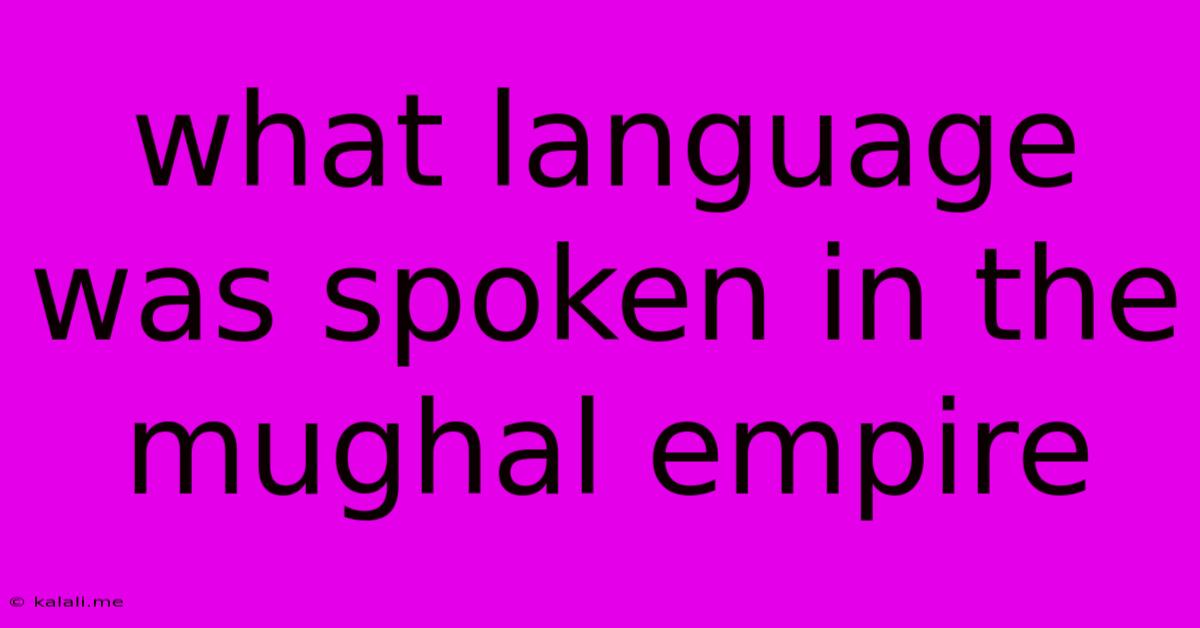What Language Was Spoken In The Mughal Empire
Kalali
Jun 14, 2025 · 3 min read

Table of Contents
What Language Was Spoken in the Mughal Empire? A Multi-Lingual Tapestry
The Mughal Empire, a vast and powerful realm that dominated much of the Indian subcontinent for centuries, wasn't characterized by a single, monolithic language. Instead, its linguistic landscape was a vibrant and complex tapestry woven from Persian, Arabic, Turkish, and various regional Indian languages. Understanding the linguistic dynamics of the Mughal era requires looking beyond a simple "official language" designation and appreciating the nuanced ways language reflected power, culture, and social hierarchy.
This article delves into the diverse linguistic landscape of the Mughal Empire, exploring the roles of different languages and their impact on the empire's cultural and administrative structures.
Persian: The Language of Power and Prestige
Persian, or Farsi, undoubtedly held the most prominent position. Adopted by the Timurid founders of the Mughal dynasty, it quickly became the lingua franca of the imperial court, administration, and elite culture. Royal decrees, official documents, court poetry, and much of the empire's literature were composed in Persian. This dominance stemmed from the Mughals' own cultural heritage and their deliberate efforts to establish a unified administrative and cultural framework across their diverse territories. Learning Persian became a key marker of social status and access to power. Think of it as the equivalent of learning Latin in medieval Europe - essential for advancement within the elite circles.
Arabic: The Language of Religion and Scholarship
While not as widely spoken as Persian, Arabic maintained significant importance, primarily due to its status as the language of Islam. Religious texts, scholarly works, and religious discourse were predominantly conducted in Arabic. The Mughal emperors, although deeply influenced by Persian culture, were devout Muslims, and the religious significance of Arabic ensured its continued presence in the empire's intellectual and spiritual life. Many elite members of society, especially those involved in religious scholarship and administration, were proficient in Arabic.
Turkish: The Language of the Military and the Emperors
Turkish, particularly Chagatai Turkish, also played a role, reflecting the empire's Central Asian origins and the strong military presence of Turkic soldiers and officials. While not as widely used in administration as Persian, Turkish retained a distinct presence in the military and amongst the emperor's personal retinue. Think of it as a language that permeated informal conversations within specific segments of the elite, rather than widespread official communication.
Regional Indian Languages: The Languages of the People
The vast majority of the population, of course, spoke various regional Indian languages. These languages, including Hindi, Urdu, Bengali, Marathi, and many others, were the languages of everyday life, commerce, and local administration. While the imperial court primarily functioned in Persian, the Mughals recognized the necessity of communicating with the diverse populace. This led to the development of a hybrid language, Hindustani, which incorporated elements of Persian and various Indian vernaculars, which in turn further influenced and evolved into both Hindi and Urdu.
The Evolution of Hindustani: A Linguistic Synthesis
The rise of Hindustani showcases a fascinating linguistic blending. As Persian became the language of power, it permeated the local vernaculars, leading to the evolution of a new register and language that facilitated communication between the ruling elite and the common people. Over time, this process led to the divergence of Hindustani into two distinct, yet closely related languages: Hindi and Urdu. While sharing a common ancestor, they use different scripts and have adopted diverse linguistic influences.
In conclusion, the linguistic landscape of the Mughal Empire was a multifaceted blend of languages reflecting the empire's diverse origins and complex social structures. While Persian held the dominant position in court and administration, Arabic maintained its religious importance, and Turkish its military relevance. Ultimately, the widespread adoption of Hindustani showcased the empire’s ability – and need – to bridge the communication gap between its diverse population and the ruling elite. This multifaceted linguistic story highlights the vibrant and dynamic interactions between cultures and languages that characterized the Mughal Empire.
Latest Posts
Latest Posts
-
Electric Current Is Defined As The Flow Of
Jun 14, 2025
-
Which Of The Following Is A Primary Pollutant
Jun 14, 2025
-
Difference Between A Physical Map And A Political Map
Jun 14, 2025
-
Definition Of Normal Profit In Economics
Jun 14, 2025
-
Is 23 A Multiple Of 3
Jun 14, 2025
Related Post
Thank you for visiting our website which covers about What Language Was Spoken In The Mughal Empire . We hope the information provided has been useful to you. Feel free to contact us if you have any questions or need further assistance. See you next time and don't miss to bookmark.